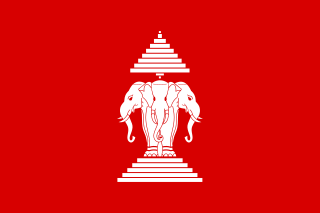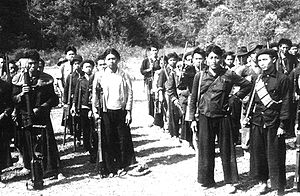Major-General Kouprasith Abhay was a prominent military leader of the Kingdom of Laos during the Laotian Civil War. Scion of a socially prominent family, his military career was considerably aided by their influence. In early 1960, he was appointed to command of Military Region 5, which included Laos' capital city, Vientiane. Removed from that command on 14 December for duplicitous participation in the Battle of Vientiane, he was reappointed in October 1962. He would hold the post until 1 July 1971, thus controlling the troops in and around the capital. Over the years, he would be involved in one way or another in the coups of 1960, 1964, 1965, 1966, and 1973. His service was marked by a deadly feud with another Laotian general, Thao Ma; the feud was largely responsible for the latter two coup attempts against the government.
The Programs Evaluation Office was a covert paramilitary mission to the Kingdom of Laos, established on 13 December 1955 by the United States Department of Defense. The 23 July 1962 International Agreement on the Neutrality of Laos would cause it to be shut down in September 1962. It would be succeeded by the Requirements Office.

The Royal Lao Army, also designated by its anglicized title RLA, was the Land Component of the Royal Lao Armed Forces (FAR), the official military of the Kingdom of Laos during the North Vietnamese invasion of Laos and the Laotian Civil War between 1960 and 1975.

James William Lair was an influential Central Intelligence Agency paramilitary officer from the Special Activities Division. He was a native Texan, raised in a broken family, but a good student. He joined the CIA after serving in a combat unit in Europe during World War II, followed by a geology degree from Texas A&M. In his senior year, he was recruited by the CIA.
The Battle of Nam Bac was one of the major engagements of the Laotian Civil War. Despite misgivings about their potential performance the Royal Lao Army moved in to occupy the Nam Bac Valley in August 1966; the position would block a traditional Vietnamese invasion route that led to the Lao royal capitol, Luang Prabang.
The Battle of Lak Sao, fought between November 1963 and January 1964, was a major engagement of the Laotian Civil War. In November 1963, General Phoumi Nosavan, who held the reins of military power in the Kingdom of Laos, launched a military offensive against North Vietnamese invaders that cut across the northern panhandle of the nation. Although unsupported in this proxy action by his backers in the U.S. Embassy, he went ahead with his plan to push northwards from Nhommarath, then veer eastwards to the Vietnamese border. Phoumi's Central Intelligence Agency (CIA) advisors warned him that the North Vietnamese would retaliate, but he disregarded them.
The Auto Defense de Choc company basic training program was a short intensive course in military tactics; it was developed at the start of the Laotian Civil War to begin a guerrilla movement in Laos. The ADC training that took place in the face of the North Vietnamese and Pathet Lao communist troops was so successful it was copied elsewhere, including Operation Pincushion in Laos, and among the Degar of South Vietnam. The ADC program consisted of prepacked military equipment suitable for training 100 recruits at a time.
Operation Pincushion was a covert training program for hill tribe recruits to become guerrilla soldiers during the Laotian Civil War. Run by United States Special Forces and funded by the Central Intelligence Agency, it trained 12 companies of irregulars in southern Laos between December 1961 and September 1962. These guerrilla forces were near the Ho Chi Minh Trail, and intended to secure the Royal Lao Government's hold on the Bolovens Plateau.
Operation Momentum was a guerrilla training program during the Laotian Civil War. This Central Intelligence Agency operation raising a guerrilla force of Hmong hill-tribesmen in northeastern Laos was planned by James William Lair and carried out by the Thai Police Aerial Reinforcement Unit. Begun on 17 January 1961, the three-day Auto Defense Choc course graduated a clandestine guerrilla army of 5,000 warriors by 1 May, and of 9,000 by August. It scored its first success the day after the first ADC company graduated, on 21 January 1961, when 20 ADC troopers ambushed and killed 15 Pathet Lao.
Operation Triangle was a military operation of the Laotian Civil War staged from 19—29 July 1964. Although planned by the General Staff of the Royal Lao Army, it was subject to American approval because the RLA depended on the Americans for finances, supplies, and munitions. Operation Triangle was an ambitious undertaking dependent on martial skills unfamiliar to the Lao. It not only called for coordination of infantry, artillery, and tactical air strikes among forces of three different nationalities; as a covert operation, it also had to have plausible deniability.
The Wapi Project was a civic action program originated by the Royal Lao Government; it was performed in Military Region 4 of Laos from late 1963 through 1967. Notable for being among the first integrated programs to offer integrated services to the Lao Theung populace of southern Laos, it became a victim of its own success. Its lean efficiency led to its being crowded out of funding by more expensive programs.
The Battle of Ban Pa Dong was fought between 31 January and 6 June 1961 in Ban Pa Dong, the Kingdom of Laos. Troops from the People's Army of Vietnam (PAVN) and the Pathet Lao attacked Hmong recruits being trained as Auto Defense Choc guerrillas via Operation Momentum. Although the Hmong made the tactical error of defending a fixed position, their eventual escape from the communist invaders left their fledgling L'Armee Clandestine intact and able to wage war for the Royal Lao Government. However, they abandoned four howitzers and two mortars to the victorious Vietnamese communists. The partisans had also set a deleterious precedent for themselves with their defense of a fixed position.
General Sang Kittirath was a prominent military leader during the Laotian Civil War in the Kingdom of Laos. Between January 1955 and January 1965, he was successively the commander of Military Region 2 and head of the Ground Forces Command. His performance as commander of the losing side at the Battle of Lak Sao in early 1964, plus the loss of support from its political patron Major-General Phoumi Nosavan, led to Sang's resignation from command.
Kou Kiet was a major Laotian Civil War victory for the anti-communist troops of the Kingdom of Laos. Patterned after prior Operation Raindance, it depended upon extensive air strikes blasting communist units and clearing them from the path of the Royalist offensive. Powered by 150 daylight and 50 night sorties daily, with 50 to 80 day strikes directed by Raven Forward Air Controllers, Kou Kiet ran from 6 August to 30 September 1969. It was successful beyond expectations. After the Royal Lao Government troops achieved their objectives, General Vang Pao insisted on pushing forward while they had the initiative. As a result, the Royalists regained control of the entire Plain of Jars while also capturing a huge stock of munitions from the communists. Their triumph came at a cost. However successful the Royalists were, by battle's end their battle-worn forces had exhausted their pool of potential recruits, while the Vietnamese could easily replace their personnel losses.
Campaign 139 was a major military offensive of the People's Army of Vietnam, launched against its Royalist enemies during the Laotian Civil War. Larger than previous invading forces, Campaign 139 was also a combined arms expedition containing tanks, artillery, engineers, and Dac Cong sappers. As such, it was a decided escalation in the war. It was also an exceptional rainy season offensive by PAVN, which usually withdrew during the wet season.
The Tchepone Operation was an interdiction campaign by the Royal Lao Armed Forces aimed at disrupting the People's Army of Vietnam (PAVN) supply line, the Ho Chi Minh trail. The pair of three-battalion Central Intelligence Agency-sponsored Royalist irregular columns aimed at a communist garrison at Moung Phine, and the vital transshipment point of Tchepone. The Muang Phine thrust was fruitless. The Tchepone column stalled on Route 9 only 13 kilometers from the logistics center on 31 October. Between 1 and 10 November, the PAVN fiercely attacked while reinforced with nine antiaircraft guns and six mortars. The Royalist guerrillas retreated to base under cover of tactical air strikes by the Royal Lao Air Force and U.S. Air Force that inflicted heavy casualties on the PAVN, including close air support delivered within 20 meters of the Royalists. Analysis of the results of the Tchepone Operation convinced the CIA that regimental operations should replace multi-battalion ones.
Project Copper was a coordinated military action undertaken by the Kingdom of Laos and the Khmer Republic from 1 January–May 1971. It used U.S. Department of Defense (DOD) funds channeled through the Central Intelligence Agency to train three Cambodian battalions to interdict the Sihanouk Trail before it joined the Ho Chi Minh Trail. Committed to battle in southern Laos on 1 January 1971, one battalion deserted the battlefield, a second one mutinied during training, and a third had to be repurposed after suffering 80 casualties. By late January, the project was temporarily suspended.
Operation Sinsay was a Royal Lao Government offensive of the Laotian Civil War. The planned offensive was pre-empted by prior moves by the opposing People's Army of Vietnam (PAVN); they struck on 6 March 1972. Although the Communist attack reached Laongam, 21 kilometers from Pakxe and the Thai border, and the defending Royalist battalions there were reassigned to fight in Operation Strength on the Plain of Jars, monarchist guerrillas were able to interdict Communist supply lines and force a Vietnamese retreat by the end of March 1972.
The Battles of Bouamlong came about because the valley of Bouamlong was a center of Royalist guerrilla operations during the Laotian Civil War. Located well into Communist-held territory and maintained by an air bridge, on several occasions Bouamlong served as a launching point for Royalist offensives such as Operation Raindance, Kou Kiet, Operation Counterpunch III, and Operation Strength. It was also targeted for attack by offensives by the People's Army of Vietnam during Campaign 139 and Campaign 74B. Defended by Auto Defense Choc troops led by Major Cher Pao Moua, Bouamlong held out against the Communist forces even after the War ended in a ceasefire in February 1973. There were reports of resistance into the 1990s.
Unity was the code name for Thailand's covert supply of mercenary soldiers to the Kingdom of Laos during the Laotian Civil War. From 4 July 1964 until March 1973, battalions of Thai volunteers fought Communist insurgents on the Plain of Jars in Military Region 2. As the Hmong L'Armée Clandestine was sapped by ongoing casualties and a limited basis for replacements, Unity battalions replaced them.


